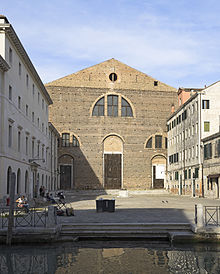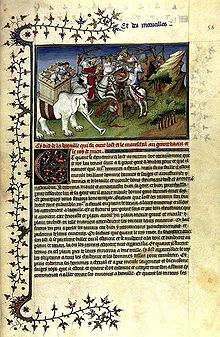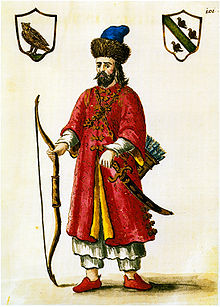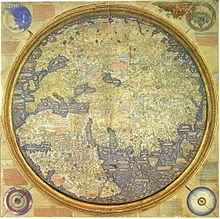- Marco Polo
-
This article is about the trader and explorer. For other uses, see Marco Polo (disambiguation).
Marco Polo 
Portrait of Marco Polo[Note 1]Born c. 1254, presumably in Venice, Italy Died January 9, 1324 (aged 69)
Venice, Venetian RepublicResting place Church of San Lorenzo
45°15′41″N 12°12′15″E / 45.2613°N 12.2043°EOccupation Merchant, Explorer Known for The Travels of Marco Polo Spouse Donata Badoer Children Fantina, Bellela, and Moretta Parents Mother: Unknown
Father: Niccolò PoloMarco Polo (English pronunciation: /ˈmɑrkoʊ ˈpoʊloʊ/ (
 listen); Italian pronunciation: [ˈmarko ˈpɔːlo]; c. 1254 – January 9, 1324)[1] was a Venetian merchant traveler[2][3] from the Venetian Republic whose travels are recorded in Il Milione, a book which did much to introduce Europeans to Central Asia and China. He learned about trading whilst his father and uncle, Niccolò and Maffeo, travelled through Asia and apparently met Kublai Khan. In 1269, they returned to Venice to meet Marco for the first time. The three of them embarked on an epic journey to Asia, returning after 24 years to find Venice at war with Genoa; Marco was imprisoned, and dictated his stories to a cellmate. He was released in 1299, became a wealthy merchant, married and had 3 children. He died in 1324, and was buried in San Lorenzo.
listen); Italian pronunciation: [ˈmarko ˈpɔːlo]; c. 1254 – January 9, 1324)[1] was a Venetian merchant traveler[2][3] from the Venetian Republic whose travels are recorded in Il Milione, a book which did much to introduce Europeans to Central Asia and China. He learned about trading whilst his father and uncle, Niccolò and Maffeo, travelled through Asia and apparently met Kublai Khan. In 1269, they returned to Venice to meet Marco for the first time. The three of them embarked on an epic journey to Asia, returning after 24 years to find Venice at war with Genoa; Marco was imprisoned, and dictated his stories to a cellmate. He was released in 1299, became a wealthy merchant, married and had 3 children. He died in 1324, and was buried in San Lorenzo.Their pioneering journey inspired Christopher Columbus[4] and others. Marco Polo's other legacies include Venice Marco Polo Airport, the Marco Polo sheep, and several books and films. He also had an influence on European cartography, leading to the introduction of the Fra Mauro map.
Contents
Life
Early life and Asian travel
See also: Niccolò and Maffeo PoloThe exact time and place of Marco Polo's birth are unknown, and current theories are mostly conjectural. One possible place of birth is Venice's former contrada of San Giovanni Crisostomo, which is sometimes presented by historians as the birthplace, and it is generally accepted that Marco Polo was born in the Venetian Republic with most biographers pointing towards Venice itself as Marco Polo's home town.[5] Some biographers suggest that Polo was born in the town of Korčula (Curzola), on the island of Korčula in today's Croatia, however there is no proof to this claim.[6][7] The most quoted specific date of Polo's birth is somewhere "around 1254".[Note 2] His father Niccolò was a merchant who traded with the Middle East, becoming wealthy and achieving great prestige.[8][9] Niccolò and his brother Maffeo set off on a trading voyage, before Marco was born.[9] In 1260, Niccolò and Maffeo were residing in Constantinople when they foresaw a political change; they liquidated their assets into jewels and moved away.[8] According to The Travels of Marco Polo, they passed through much of Asia, and met with the Kublai Khan.[10] Meanwhile, Marco Polo's mother died, and he was raised by an aunt and uncle.[9] Polo was well educated, and learned merchant subjects including foreign currency, appraising, and the handling of cargo ships,[9] although he learned little or no Latin.[8]
In 1269, Niccolò and Maffeo returned to Venice, meeting Marco for the first time. In 1271, Marco Polo (at seventeen years of age), his father, and his uncle set off for Asia on the series of adventures that were later documented in Marco's book. They returned to Venice in 1295, 24 years later, with many riches and treasures. They had traveled almost 15,000 miles (24,000 km).[9]
Genoese captivity and later life
See also: Battle of CurzolaUpon the Polos' return to Italy, Venice was at war with Genoa.[11] Genoese admiral Lamba D'Oria overwhelmed a Venetian fleet at the Battle of Curzola near the island of Korčula, and Polo was taken prisoner.[11] He spent several months of his imprisonment dictating a detailed account of his travels to a fellow inmate, Rustichello da Pisa,[9] who incorporated tales of his own as well as other collected anecdotes and current affairs from China. The book, soon spread throughout Europe in manuscript form, became known as The Travels of Marco Polo, and depicts the Polos' journeys throughout Asia, giving Europeans their first comprehensive look into the inner workings of the Far East, including China, India, and Japan.[12]
While Polo's book describes paper money and the burning of coal, it fails to mention the Great Wall of China, chopsticks, and footbinding, making skeptics wonder if Marco Polo had really gone to China, or wrote his book based on hearsay.[13] However, researchers note that the Great Wall familiar to us today is a Ming structure, post-dating Marco Polo's travels by more than two centuries. The Yuan rulers whom Polo served, as well as the preceding Jin and Liao Empires controlled territories both north and south of the today's wall, and would have no reasons to maintain any fortifications that may have remained there from the earlier dynasties.[14] Other Europeans who traveled to Khanbaliq during the Yuan Dynasty, such as Giovanni de' Marignolli and Odoric of Pordenone, said nothing about the wall either.[14]
Polo was finally released from captivity in August 1299,[9] and returned home to Venice, where his father and uncle had purchased a large house in the central quarter named contrada San Giovanni Crisostomo. The company continued its activities and Marco soon became a wealthy merchant. Polo financed other expeditions, but never left Venice again. In 1300, he married Donata Badoer, the daughter of Vitale Badoer, a merchant.[15] They had three daughters, called Fantina, Bellela and Moreta.[16]
Death
In 1323, Polo was confined to bed, due to illness. On January 8, 1324, despite physicians' efforts to treat him, Polo was on his deathbed. To write and certify the will, his family requested Giovanni Giustiniani, a priest of San Procolo. His wife, Donata, and his three daughters were appointed by him as co-executrices. The church was entitled by law to a portion of his estate; he approved of this and ordered that a further sum be paid to the convent of San Lorenzo, the place where he wished to be buried.[1] He also set free a "Tartar slave" who may have accompanied him from Asia.[17]
He divided up the rest of his assets, including several properties, between individuals, religious institutions, and every guild and fraternity to which he belonged. He also wrote-off multiple debts including 300 lire that his sister-in-law owed him, and others for the convent of San Giovanni, San Paolo of the Order of Preachers, and a cleric named Friar Benvenuto. He ordered 220 soldi be paid to Giovanni Giustiniani for his work as a notary and his prayers.[1] The will, which was not signed by Polo, but was validated by then relevant "signum manus" rule, by which the testator only had to touch the document to make it abide to the rule of law,[18] was dated January 9, 1324. Due to the Venetian law stating that the day ends at sunset, the exact date of Marco Polo's death cannot be determined, but it was between the sunsets of January 8 and 9, 1324.[1]
Travels of Marco Polo
Further information: The Travels of Marco PoloA miniature from Il Milione.
An authoritative version of Marco Polo's book does not exist, and the early manuscripts differ significantly. The published versions of his book either rely on single scripts, blend multiple versions together or add notes to clarify, for example in the English translation by Henry Yule. Another English translation by A.C. Moule and Paul Pelliot, published in 1938, is based on the Latin manuscript which was found in the library of the Cathedral of Toledo in 1932, and is 50% longer than other versions.[19] Approximately 150 variants in various languages are known to exist, and without the availability of a printing press many errors were made during copying and translation, resulting in many discrepancies.[20] Polo related his memoirs to Rustichello da Pisa while both were prisoners of the Genova Republic. Rustichello wrote The Devisament du Monde in Langues d'Oil, a lingua franca of crusaders and western merchants in the orient.[21] The idea probably was to create a handbook for merchants, essentially a text on weights, measures and distances.[22]
Narrative
The book starts with a preface about his father and uncle traveling to Bolghar where Prince Berke Khan lived. A year later, they went to Ukek[23] and continued to Bukhara. There, an envoy from Levant invited them to meet Kublai Khan, who had never met Europeans.[24] In 1266, they reached the seat of the Kublai Khan at Dadu, present day Beijing, China. Khan received the brothers with hospitality and asked them many questions regarding the European legal and political system.[25] He also inquired about the Pope and Church in Rome.[26] After the brothers answered the questions he tasked them with delivering a letter to the Pope, requesting 100 Christians acquainted with the Seven Arts (grammar, rhetoric, logic, geometry, arithmetic, music and astronomy). Kublai Khan requested that an envoy bring him back oil of the lamp in Jerusalem.[27] The long sede vacante between the death of Pope Clement IV in 1268 and the election of his successor delayed the Polos in fulfilling Khan's request. They followed the suggestion of Theobald Visconti, then papal legate for the realm of Egypt, and returned to Venice in 1269 or 1270 to await the nomination of the new Pope, which allowed Marco to see his father for the first time, at the age of fifteen or sixteen.[28]
In 1271, Niccolò, Maffeo and Marco Polo embarked on their voyage to fulfill Khan's request. They sailed to Acre, and then rode on camels to the Persian port of Hormuz. They wanted to sail to China, but the ships there were not seaworthy, so they continued overland until reaching Khan's summer palace in Shangdu, near present-day Zhangjiakou. Three and one-half years after leaving Venice, when Marco was about 21 years old, Khan welcomed the Polos into his palace.[9] The exact date of their arrival is unknown, but scholars estimate it to be between 1271 and 1275.[Note 3] On reaching the Yuan court, the Polos presented the sacred oil from Jerusalem and the papal letters to their patron.[8]
Marco knew four languages, and the family had accumulated a great deal of knowledge and experience that was useful to Khan. It is possible that he became a government official;[9] he wrote about many imperial visits to China's southern and eastern provinces, the far south and Burma.[29]
Kublai Khan declined the Polos' requests to leave China. They became worried about returning home safely, believing that if Khan died, his enemies might turn against them because of their close involvement with the ruler. In 1292, Khan's great-nephew, then ruler of Persia, sent representatives to China in search of a potential wife, and they asked the Polos to accompany them, so they were permitted to return to Persia with the wedding party – which left that same year from Zaitun in southern China on a fleet of 14 junks. The party sailed to the port of Singapore, travelled north to Sumatra, sailed west to the Trincomalee port of Jaffna under Savakanmaindan and to Pandyan of Tamilakkam. Describing the Pandyan kingdom under Lord Emperor Jatavarman Sundara Pandyan I as the richest empire in existence, Polo arrived during the reign of Maravarman Kulasekara Pandyan I, son of Jatavarman Sundara Pandyan I and one of five brother kings on the continent.[30] Eventually Polo crossed the Arabian Sea to Hormuz. The two-years voyage was a perilous one – of the six hundred people (not including the crew) in the convoy only eighteen had survived (including all three Polos).[31] The Polos left the wedding party after reaching Hormuz and travelled overland to the port of Trebizond on the Black Sea, the present day Trabzon.[9]
Legacy
Further exploration
 Handwritten notes by Christopher Columbus on a Latin edition of Polo's book.
Handwritten notes by Christopher Columbus on a Latin edition of Polo's book.
Other lesser-known European explorers had already travelled to China, such as Giovanni da Pian del Carpine, but Polo's book meant that their journey was the first to be widely known. Christopher Columbus was inspired enough by Polo's description of the Far East to visit those lands for himself; a copy of the book was among his belongings, with handwritten annotations.[4] Bento de Góis, inspired by Polo's writings of a Christian kingdom in the east, travelled 4,000 miles (6,400 km) in three years across Central Asia. He never found the kingdom, but ended his travels at the Great Wall of China in 1605, proving that Cathay was what Matteo Ricci (1552–1610) called "China".[32]
Commemoration
The Marco Polo sheep, a subspecies of Ovis aries, is named after the explorer,[33] who described it during his crossing of Pamir (ancient Mount Imeon) in 1271.[Note 4] In 1851, a three-masted Clipper built in Saint John, New Brunswick also took his name; the Marco Polo was the first ship to sail around the world in under six months.[34] The airport in Venice is named Venice Marco Polo Airport,[35] and the frequent flyer program of Hong Kong flag carrier Cathay Pacific is known as the "Marco Polo Club".[36] The travels of Marco Polo are fictionalised in Brian Oswald Donn-Byrne's Messer Marco Polo and Gary Jennings' 1984 novel The Journeyer. Polo also appears as the pivotal character in Italo Calvino's novel Invisible Cities. The 1982 television miniseries, Marco Polo, directed by Giuliano Montaldo and depicting Polo's travels, won two Emmy Awards and was nominated for six more.[37] Marco Polo also appears as a Great Explorer in the 2008 strategy video game Civilization Revolution.[38]
Cartography
Marco Polo's travels may have had some influence on the development of European cartography, ultimately leading to the European voyages of exploration a century later.[39] The 1453 Fra Mauro map was said by Giovanni Battista Ramusio to have been partially based on the one brought from Cathay by Marco Polo:
That fine illuminated world map on parchment, which can still be seen in a large cabinet alongside the choir of their monastery (the Camaldolese monastery of San Michele di Murano) was by one of the brothers of the monastery, who took great delight in the study of cosmography, diligently drawn and copied from a most beautiful and very old nautical map and a world map that had been brought from Cathay by the most honourable Messer Marco Polo and his father.See also
- Chronology of European exploration of Asia
- Silk Road, which Marco Polo traveled.
- 1284 Yuan expedition to Sri Lanka
- Did Marco Polo go to China?
Notes
- ^ The exact source is unknown, but the portrait originated from a 16th century painting in the Gallery of Monsignor Badia in Rome. Inscription: Marcus Polus venetus totius orbis et Indie peregrator primus. It appears in the Nordisk familjebok Berg 1915, p. 1261
- ^ Many sources state this date; Britannica 2002, p. 571 states, "born in or around 1254. (This date, like nearly all the others concerning major events in his life, is conjectural.)"
- ^ Drogön Chögyal Phagpa, a Tibetan monk and confidant of Kublai Khan, mentions in his diaries that in 1271 a foreign friend of Kublai Khan visits — quite possibly one of the elder Polos or even Marco Polo himself, although, no name was given. If this is not the case, a more likely date for their arrival is 1275 (or 1274, according to the research of Japanese scholar Matsuo Otagi).(Britannica 2002, p. 571)
- ^ Yule & Cordier 1923, ch.18 states, "Then there are sheep here as big as asses; and their tails are so large and fat, that one tail shall weigh some 30 lb. They are fine fat beasts, and afford capital mutton."
References
- ^ a b c d Bergreen 2007, pp. 339–342
- ^ William Tait, Christian Isobel Johnstone (1843). Tait's Edinburgh magazine, Volume 10. Edinburgh.
- ^ Hinds, Kathryn (2002). Venice and Its Merchant Empire. New York.
- ^ a b Landström 1967, p. 27
- ^ Bergreen 2007, p. 25
- ^ Burgan 2002, p. 7
- ^ Brook 2010, p. 24
- ^ a b c d Britannica 2002, p. 571
- ^ a b c d e f g h i j Parker 2004, pp. 648–649
- ^ Yule & Cordier 1923, ch.1–9
- ^ a b Nicol 1992, p. 219
- ^ Bram 1983
- ^ John Grant, Corrupted Science, Facts, Figures & Fun, 2007, p. 21, ISBN 9781904332732
- ^ a b Haw, Stephen G. (2006), Marco Polo's China: a Venetian in the realm of Khubilai Khan, Volume 3 of Routledge studies in the early history of Asia, Psychology Press, pp. 52–57, ISBN 0415348501, http://books.google.com/books?id=CdE6Q_2yICIC&pg=PA52
- ^ Bergreen 2007, p. 532
- ^ Power 2007, p. 87
- ^ Britannica 2002, p. 573
- ^ Biblioteca Marciana, the institute that holds Polo's original copy of his testament. Venezia.sbn.it
- ^ Bergreen 2007, pp. 367–368
- ^ Edwards, p. 1
- ^ ^ Marco Polo, Il Milione, Adelphi 2001, ISBN 88-459-1032-6, Prefazione di Bertolucci Pizzorusso Valeria, pp. X-XXI.
- ^ ^ Larner John, Marco Polo and the discovery of the world, Yale University Press, 1999, ISBN 0300079710 pp. 68–87.
- ^ Yule & Cordier 1923, ch. 2
- ^ Yule & Cordier 1923, ch. 3
- ^ Yule & Cordier 1923, ch. 5
- ^ Yule & Cordier 1923, ch. 6
- ^ Yule & Cordier 1923, ch. 7
- ^ Yule & Cordier 1923, ch. 9
- ^ W. Marsden (2004), Thomas Wright, ed. (PDF), The Travels pf Marco Polo, The Venetian (1298), http://web.soas.ac.uk/burma/pdf/Polo.pdf, retrieved 2009-07-14
- ^ Aiyangar, Sakkottai Krishnaswami (1921). South India and her Muhammadan Invaders. Oxford University Press.
- ^ Boyle, J. A. (1971). Marco Polo and his Description of the World. History Today. Vol. 21, No. 11. Historyoftoday.com
- ^ Winchester 2008, p. 264
- ^ Bergreen 2007, p. 74
- ^ Lubbock 2008, p. 86
- ^ Brennan, D. (2009-02-01), Lost in Venice, WalesOnline, http://www.walesonline.co.uk/travel/travel-news/2009/02/01/lost-in-venice-91466-22826493/, retrieved 2009-07-15[dead link]
- ^ Cathay Pacific Airways (2009), The Marco Polo Club, Cathay Pacific Airways Limited, http://www.cathayforbusiness.com/freqfly/marcopoloclub.asp, retrieved 2009-07-13
- ^ Academy of Television Arts & Sciences, http://www.emmys.org/awards/awardsearch.php, retrieved 2009-07-06 (Searching for "Marco Polo", and year 1982)
- ^ Civilization Revolution: Great People "CivFanatics" Retrieved on 2009-09-04
- ^ a b Falchetta 2006, p. 592
Bibliography
- Basil, Lubbock (2008), The Colonial Clippers, Read Books, ISBN 9781443771191
- Berg, R. G:son; Söderberg, V. (1915) (in Swedish), Nordisk familjebok (en. Nordic familybook) (Uggleupplagan ed.), Stockholm: Project Runeberg, http://runeberg.org/nfca/0687.html
- Bergreen, Laurence (2007), Marco Polo: From Venice to Xanadu, London: Quercus, ISBN 9781847243454
- Bram, Leon L.; Robert S., Phillips; Dickey, Norma H. (1983), Funk & Wagnalls New Encyclopedia, New York: Funk & Wagnalls, ISBN 9780834300514 (Article republished in 2006 World Almanac Books, available online from History.com)
- Brook, Timothy (2010), The Troubled Empire: China in the Yuan and Ming Dynasties, Harvard University Press, ISBN 0674046021, 9780674046023, http://books.google.com/?id=b80ePdTYWXoC&pg=PA24&dq=Marco+Polo+Korcula#v=onepage&q=Marco%20Polo%20Korcula&f=false
- Burgan, Michael (2002), Marco Polo: Marco Polo and the silk road to China, Mankato: Compass Point Books, ISBN 9780756501808, http://books.google.com/?id=3aPF0rgdslUC&dq=Marco+Polo:+Marco+Polo+and+the+silk+road+to+China&printsec=frontcover&q=Korcula
- Britannica Editors (2002), "Marco Polo", The New Encyclopædia Britannica Macropedia, 9 (15 ed.), Encyclopædia Britannica, Inc, ISBN 9780852297872
- Edwards, Mike (2005), Marco Polo, Part 1, Washington, D.C.: National Geographic Society, http://ngm.nationalgeographic.com/ngm/0105/feature1/index.html
- Falchetta, Piero (2006), Fra Mauro's World Map, Turnhout: Brepols, ISBN 2503517269
- Henry Yule; Henri Cordier (1923), The Travels Of Marco Polo, Mineola: Dover Publications, ISBN 9780486275864, http://en.wikisource.org/wiki/The_Travels_of_Marco_Polo
- Landström, Björn (1967), Columbus: the story of Don Cristóbal Colón, Admiral of the Ocean, New York City: Macmillan
- Marco Polo. (2010). In Encyclopædia Britannica. Retrieved 2010-08-28, from Encyclopædia Britannica Online: http://www.britannica.com/EBchecked/topic/468139/Marco-Polo
 "Marco Polo". Catholic Encyclopedia. New York: Robert Appleton Company. 1913.
"Marco Polo". Catholic Encyclopedia. New York: Robert Appleton Company. 1913.- McKay, John; Bennet Hill and John Buckler (2006), A History of Western Society (Eighth ed.), Houghton Mifflin Company, p. 506, ISBN 0618522662
- Nicol, Donald M. (1992), Byzantium and Venice: a study in diplomatic and cultural relations, Cambridge University Press, ISBN 0521428947, 9780521428941
- Parker, John (2004), "Marco Polo", The World Book Encyclopedia, 15 (illustrated ed.), United States: World Book, Inc., ISBN 9780716601043
- Power, Eileen Edna (2007), Medieval People, BiblioBazaar, ISBN 9781426467776
- Winchester, Simon (2008-05-06), The Man Who Loved China: Joseph Needham and the Making of a Masterpiece, New York: HarperCollins, ISBN 9780060884598
- Wood, Frances (1998), Did Marco Polo Go To China?, Westview Press, ISBN 0813389992, http://books.google.com/?id=yMRVjwNIqW0C&printsec=frontcover&dq=Did+Marco+Polo+Go+to+China%3F&q=
Further reading
- Marco Polo (1918). William Marsden. ed. The Travels of Marco Polo. LONDON: J.M. Dent & Sons. p. 461. http://books.google.com/books?id=VovVAAAAMAAJ&printsec=frontcover&source=gbs_ge_summary_r&cad=0#v=onepage&q&f=false. Retrieved 2011-05-29.(Original from the University of Wisconsin – Madison)
- Daftary, Farhad (1994), The Assassin legends: myths of the Ismaʻilis (2 ed.), I.B. Tauris, p. 213, ISBN 9781850437055
- Hart, H. Henry (1948), Marco Polo, Venetian Adventurer, Kessinger Publishing
- Otfinoski, Steven (2003), Marco Polo: to China and back, New York: Benchmark Books, ISBN 0761414800
- The Travels of Marco Polo – Volume 1[1] and Volume 2,[2] written by Marco Polo and Rustichello of Pisa, were published by Project Gutenberg
- Yang, Dori Jones (2011-01-11), Daughter of Xanadu, Delacorte Press Books for Young Readers, ISBN 9780385739238 (Young Adult novel)
- Dalrymple, William (1989), In Xanadu
Television
- In the Footsteps of Marco Polo is a 2009 PBS documentary about two friends (Denis Belliveau and Francis O’Donnell), who conceived of the ultimate road trip to retrace Marco Polo's journey from Venice to China via land and sea.[3]
- A 1982 miniseries featured Ken Marshall and Ruocheng Ying.[4]
- The 2007 television miniseries, Marco Polo, starring Brian Dennehy as Kublai Khan, and Ian Somerhalder as Marco, portrays Marco Polo being left alone in China while his uncle and father return to Venice, to be reunited with him many years later.[5]
- ^ "The Travels of Marco Polo – Volume 1 by Marco Polo and Rustichello of Pisa – Project Gutenberg". Gutenberg.org. 2004-01-01. http://www.gutenberg.org/etext/10636. Retrieved 2011-04-02.
- ^ "The Travels of Marco Polo – Volume 2 by Marco Polo and Rustichello of Pisa – Project Gutenberg". Gutenberg.org. 2004-05-01. http://www.gutenberg.org/etext/12410. Retrieved 2011-04-02.
- ^ WLIW.org, "In the footsteps of Marco Polo", PBS 2009
- ^ IMDb.com, Marco Polo TV Mini-series 1982
- ^ IMDb.com, Marco Polo TV Mini-series 2007
External links
- The birthplace of Marco Polo
- National Geographic Marco Polo: Journey from Venice to China
- In the Footsteps of Marco Polo: A Journey through the Met to the Land of the Great Khan
- Marco Polo at the Open Directory Project
- Works by Marco Polo at Project Gutenberg
- Marco Polo at the Internet Movie Database
Categories:- Italian Roman Catholics
- 1254 births
- 1324 deaths
- 13th-century explorers
- Italian expatriates in China
- Explorers of Asia
- Explorers of Central Asia
- Venetian explorers
- Venetian merchants
- Italian travel writers
- People from Venice (city)
Wikimedia Foundation. 2010.






